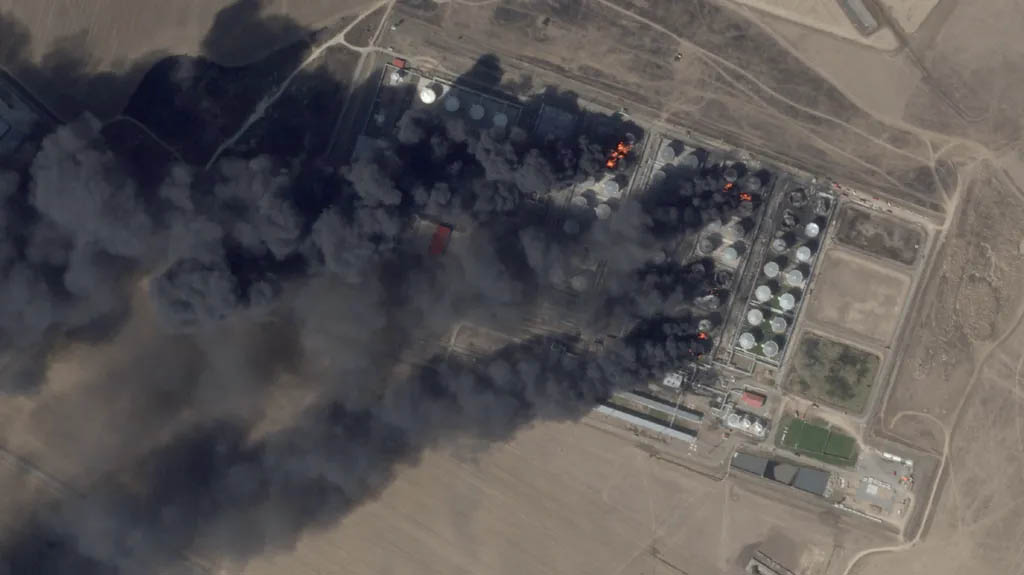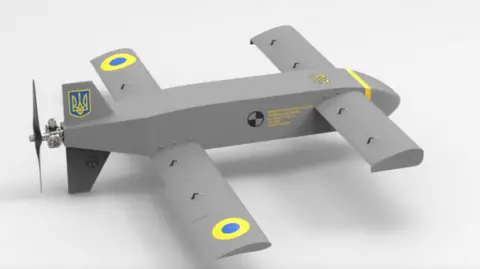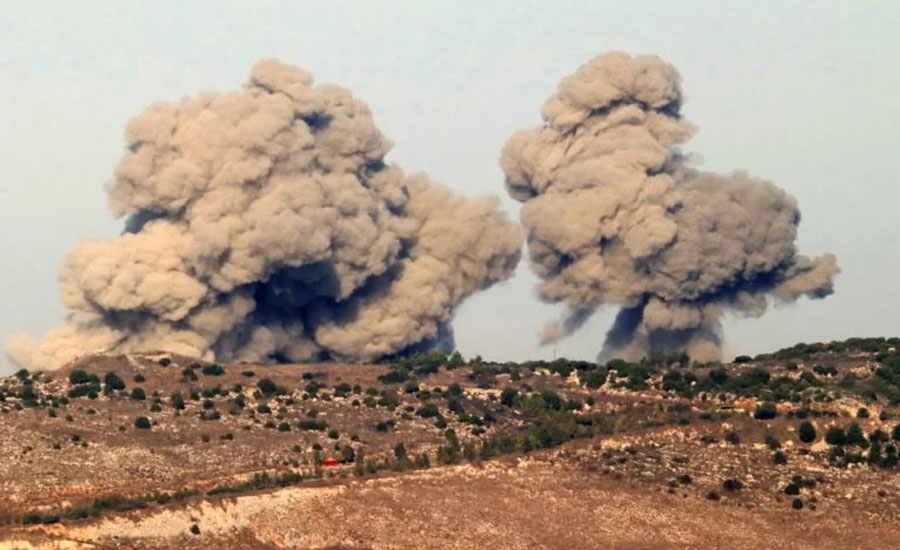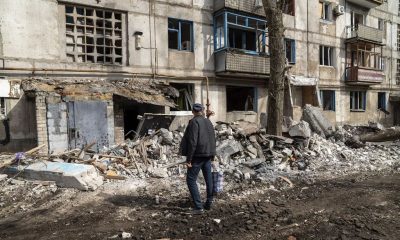International
Ukraine’s long-range drones using Western tech to hit Russia

Ukraine’s long-range drones using Western tech to hit Russia
Western technology and finance are helping Ukraine carry out hundreds of long-range strikes inside Russia.
That is despite Nato allies still refusing to give Ukraine permission to use Western-supplied munitions to do so – mostly because of fears of escalation.
Ukraine has been stepping up its long-range strikes inside Russia over the past few months, launching scores of drones simultaneously at strategic targets several times a week.
The targets include air force bases, oil and ammunition depots and command centres.
Ukrainian firms are now producing hundreds of armed one-way attack drones a month, at a fraction of the cost it takes to produce a similar drone in the West.
One company told the BBC it was already creating a disproportionate impact on Russia’s war economy at a relatively small expense.
The BBC has been briefed by a number of those involved in these missions. They include one of Ukraine’s largest one-way attack drone manufacturers, as well as a big data company which has helped develop software for Ukraine to carry out these strikes.
Francisco Serra-Martins says the strategy is already creating huge dilemmas for Moscow. He believes that with extra investment, it will turn the tide of the war in Ukraine’s favour.
Eighteen months ago, the company he co-founded, Terminal Autonomy, didn’t even exist. It is now producing more than a hundred AQ400 Scythe long-range drones a month, with a range of 750km (465 miles). The company also makes hundreds of shorter range AQ100 Bayonet drones a month, which can fly a few hundred kilometres.
The drones are made of wood and are being assembled in former furniture factories in Ukraine.
READ ALSO:
- JUST IN: NCC gives final deadline for NIN-SIM linkage
- Woman allegedly stabs neighbour for having affairs with her husband
- 54-year-old Nigerian woman delivers 11 babies in Cotonou
Mr Serra-Martins, a former Australian Army Royal Engineer, set up the company with his Ukrainian co-founder, backed by US finance. It is one of at least three companies now producing drones in Ukraine at scale.

The AQ 400 Scythe drone is made of wood and has a range of 750km
He describes his drones as “basically flying furniture – we assemble it like Ikea”.
It takes about an hour to build the fuselage and half that time to put the brains inside it – the electronics, motor and explosives.
The company’s Bayonet drone costs a few thousand dollars. In contrast, a Russian air defence missile used to shoot it down can cost more than $1m.
It is not only cheap drones making the difference.
Palantir, a large US data analysis company, was one of the first Western tech companies to aid Ukraine’s war effort. It started by providing software to improve the speed and accuracy of its artillery strikes. Now it has given Ukraine new tools to plan its long-range drone strikes.
British engineers from Palantir, working with Ukrainian counterparts, have designed a programme to generate and map the best ways to reach a target. Palantir makes clear it is not involved in the missions, but has helped train more than 1,000 Ukrainians how to use its software.
The BBC has been shown how it works in principle. Using streams of data, it can map Russia’s air defences, radar and electronic jammers. The end product looks similar to a topographical chart.
The tighter the contours, the heavier the air defences. The locations have already been identified by Ukraine using commercial satellite imagery and signals intelligence.
Louis Mosley of Palantir says the programme is helping Ukraine to skirt around Russia’s electronic warfare and air defence systems to reach their target.
READ ALSO:
- Nigerian, two others get life jail over murder in UK
- Customs seize 1,000 parcels of cannabis hidden in truck
- NSCDC arrests four in Akwa Ibom for illegal mining, power line vandalism
“Understanding and visualising what that looks like across the entire battle space is really critical to optimising these missions,” he says.
The execution of the long-range drone strikes is being co-ordinated by Ukraine’s intelligence agencies, who work in secrecy. But the BBC has been told by other sources about some of the detail.
Scores of drones can be fired for any one mission – as many as 60 at one target.
The attacks are mostly carried out at night. Most will be shot down. As few as 10% may reach the target. Some drones are even shot down along the way by friendly fire – Ukraine’s own air defences.
Ukraine has had to work out ways to counter Russian electronic jamming. Terminal Autonomy’s Scythe drone uses visual positioning – navigating its course and examining the terrain by Artificial Intelligence. There is no pilot involved.
Palantir software will have already mapped the best routes. Mr Serra-Martins says flying a lot of drones is key to overwhelming and exhausting Russia’s air defences. So too is making the drones cheaper than the missiles trying to shoot them down, or the targets they are trying to hit.
Prof Justin Bronk of the Royal United Services Institute says Ukraine’s long-range drone attacks are creating dilemmas for Moscow. Although Russia has a lot of air defences, it still cannot protect everything.
Prof Bronk says Ukraine’s long-range strikes are showing ordinary Russians that “the state can’t defend them fully and that Russia is vulnerable”.
Ukrainian drones have been spotted more than 1,000km (620 miles) inside Russia. They have been shot down over Moscow.
But the focus has been on military sites. The map below highlights just a handful of the dozen targets hit over the past few months. They include five Russian airbases.
Prof Justin Bronk says targeting Russian airbases has so far been the only effective way Ukraine has to respond to Russia’s glide bombs.
It has forced Russia to move aircraft to bases further away and reduce the frequency of their attacks. Satellite imagery shows how Ukrainian drones have successfully damaged hangars at its Marynovka airbase.
Ukraine clearly believes it could do even more with the help of Western-made long-range weapons. But so far, allies have rejected Kyiv’s pleas.
There is still a lingering fear, especially in Washington and Berlin, that it could drag the West further into the conflict. But that hasn’t stopped Western companies and finance from helping Ukraine.
Ukraine is still largely having to rely on its home-grown efforts, convinced that bringing the war to Russia is a key to winning this war.
Francisco Serra-Martins also believes Western manufacturers are still “woefully unprepared” to fight high-intensity warfare – producing far fewer long-range weapons at a much higher cost. He says what Ukraine really needs now “is a lot of good enough systems”.
The BBC has talked to one Ukrainian company which is already developing a new cruise missile, at least 10 times cheaper than a British-made Storm Shadow missile.
Despite the West’s misgivings, Ukraine is planning to step up its attacks on Russia. Mr Serra-Martins says: “What you’re seeing now is like nothing compared to what you’ll see by the end of the year.”
Ukraine’s long-range drones using Western tech to hit Russia
BBC
International
Over 330 dead as Israel unleashes ‘hell fire’ on Gaza

Over 330 dead as Israel unleashes ‘hell fire’ on Gaza
Israel vowed on Tuesday to continue fighting in Gaza until the return of all hostages as it unleashed its most intense strikes since a ceasefire, with the health ministry in the Hamas-run territory reporting more than 330 people killed.
Hamas accused Israeli Prime Minister Benjamin Netanyahu of deciding to “resume war” after an impasse in truce negotiations, and warned that the return to fighting could be a “death sentence” for hostages still alive in Gaza.
The strikes were by far the biggest and deadliest since a truce took effect on January 19. Hamas has not responded to the strikes so far.
Netanyahu warned Hamas this month of consequences it “cannot imagine” if it does not free hostages still in Gaza, and Israeli media said Israel had drafted plans to ramp up pressure on Hamas under a scheme dubbed the “Hell Plan”.
The White House said Israel consulted US President Donald Trump’s administration before launching the wave of strikes, which the health ministry in Gaza said killed mostly women and children.
Netanyahu’s office said the operation was ordered after “Hamas’s repeated refusal to release our hostages, as well as its rejection of all of the proposals it has received from US Presidential Envoy Steve Witkoff and from the mediators”.
“Israel will, from now on, act against Hamas with increasing military strength,” the statement said.
“We will not stop fighting as long as the hostages are not returned home and all our war aims are not achieved,” Defence Minister Israel Katz said.
Apart from the release of the remaining hostages, Israel’s other main war aim is to crush Hamas.
In a statement, Hamas said: “Netanyahu and his extremist government have decided to overturn the ceasefire agreement.
Over 330 dead as Israel unleashes ‘hell fire’ on Gaza
International
Trump revokes security details for Biden’s children

Trump revokes security details for Biden’s children
US President Donald Trump said Tuesday he is withdrawing Hunter Biden’s government bodyguards, extending his campaign of political retribution to Joe Biden’s son.
Trump announced the same measure against Ashley Biden, the former president’s daughter with former first lady Jill.
In a post on his Truth Social platform, Trump asserted that Hunter Biden’s security detail is composed of as many as 18 people, calling it “ridiculous.”
He said Hunter Biden was currently on vacation in South Africa and noted he had recently suspended US aid to the country over alleged rights violations.
“Please be advised that, effective immediately, Hunter Biden will no longer receive Secret Service protection. Likewise, Ashley Biden who has 13 agents will be taken off the list,” Trump wrote.
Federal law grants Secret Service protection to former presidents and their spouses, but only to their children if they are under age 16.
Nonetheless, protection is often extended for a period of time to adult children.
READ ALSO:
- Man accused of strangulating girlfriend to death in A-Ibom
- APC to El- Rufai: Stop sulking, you’re blinded by ego
- Suspected kidnapper arrested after collecting ransom in Delta
A Secret Service spokesperson, when queried about Trump’s action, told AFP: “We are aware of the President’s decision to terminate protection for Hunter and Ashley Biden.”
“The Secret Service will comply and is actively working with the protective details and the White House to ensure compliance as soon as possible.”
Hunter Biden has been a target of Republican ire for years, with the animosity intensifying after his father pardoned his gun and tax crime convictions shortly before leaving office in January.
On Monday, Trump declared that the pardon and others issued by Biden were void, an unprecedented move with unclear legal founding.
Trump revokes security details for Biden’s children
International
Trump invokes Alien Enemies Act, deports over 200 gang members

Trump invokes Alien Enemies Act, deports over 200 gang members
US President Donald Trump issued a proclamation invoking the Alien Enemies Act of 1798, accusing Tren de Aragua of “perpetrating, attempting, and threatening an invasion of predatory incursion against the territory of the United States.”
He announced that members of the gang will be deported for engaging in “irregular warfare” against the United States. The Alien Enemies Act was last used during WWII to imprison Japanese-American civilians.
On Saturday evening, US District Judge James Boasberg in Washington, DC, issued a 14-day freeze to deportations covered by Trump’s proclamation, pending more legal arguments.
After lawyers informed him that planes carrying deportees had already taken off, Judge Boasberg issued a verbal order for the planes to return, according to US media, though this command was not included in his written ruling.
According to Reuters, the written notice was filed in the court docket at 19:25 EDT on Saturday (00:25 GMT on Sunday), but it is unknown when the flights carrying the alleged gang members left the United States.
In a court filing on Sunday, Department of Justice lawyers stated that the order did not apply since the deportees “had already been removed from United States territory”.
The Justice Department has appealed the judge’s decision.
The American Civil Liberties Union, which was participating in the case against the Trump administration, stated that the court order may have been breached.
READ ALSO:
- Newcastle stun Liverpool to secure Carabao Cup victory
- 1,319 died of Diphtheria in Nigeria, says NCDC
- TUC backs NYSC member for criticising Tinubu administration
The case presents constitutional issues because, under the US system of checks and balances, government entities are expected to follow a federal judge’s decision.
Venezuela denounced Trump’s use of the Alien Enemies Act, claiming it “unjustly criminalises Venezuelan migration” and “evokes the darkest episodes in the history of humanity, from slavery to the horror of Nazi concentration camps.”
Rights organisations blasted Trump, accusing him of utilising a 227-year-old legislation to sidestep due process.
Amnesty International USA commented on X that the deportations were “yet another example of the Trump administration’s racist targeting” of Venezuelans “based on sweeping claims of gang affiliation”.
Bukele, a Trump ally, stated that the detainees were promptly taken to El Salvador’s renowned mega-jail, the Terrorism Confinement Centre (Cecot).
The Salvadoran president stated that they will be imprisoned there “for a period of one year,” which might be “renewable.”
El Salvador’s Cecot jail is part of Bukele’s efforts to combat organised crime in the country.
Human rights groups have accused the newly built maximum-security institution, which can accommodate up to 40,000 people, of mistreating inmates.
The agreement between the United States and El Salvador is an indication of improved diplomatic relations.
El Salvador was the second country Rubio visited as the US’s top diplomat.
During that trip in February, Bukele made an initial offer to accept US deportees, claiming it would help finance the enormous Cecot facility.
The newest deportations during Trump’s second term are part of the president’s long-standing campaign against illegal immigration in the United States.
In January, Trump signed an executive order designating Tren de Aragua and MS-13 as foreign terrorist organisations.
He won over voters during the campaign, in part, by threatening to carry out the greatest deportation operation in US history.
While illegal border crossings have dropped to their lowest levels in decades since Trump took office, the Republican president has allegedly been upset by the slow pace of deportations thus far.
Trump invokes Alien Enemies Act, deports over 200 gang members
-

 Entertainment2 days ago
Entertainment2 days agoVIDEO: Asake reconciles with father, promises to purchase house, cover medical bills
-

 metro20 hours ago
metro20 hours agoCorper who criticised Tinubu govt under pressure to apologise, says Sowore
-

 Education2 days ago
Education2 days agoRomanian university offers fully funded scholarships to non-EU and non-EEA students for 2025
-

 metro3 days ago
metro3 days agoObasa: Tinubu’s Abuja meeting fails to calm Lagos Assembly impasse as crisis deepens
-

 metro20 hours ago
metro20 hours agoBreaking: Trans-Niger Pipeline in Rivers explodes in fire after militants threat
-

 metro2 days ago
metro2 days agoEx-England star John Fashanu sues police for £100k after arrest in Nigeria
-

 metro3 days ago
metro3 days agoNatasha: Senate President Akpabio considers stepping down
-

 metro3 days ago
metro3 days agoWhy we supported Tinubu despite Chicago University issues — El-Rufai













